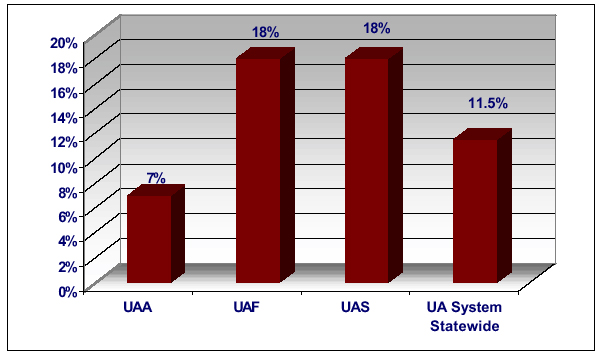University of Alaska Campuses, Fall 1999

Source: University of Alaska Statewide Office of
Budget and Institutional Research
HIGHER
EDUCATION
Research shows that Alaska Natives and American Indians are the least likely to attend and complete college of all U. S. minority groups (Benjamin, Chambers & Reiterman, 1993; Pavel, 1999; ANC, 1994). Alaska ranks 48 th among the 50 states in the number of 19-year-old high school graduates of all races who enrolled in college (Mortenson, 2000).As a whole, American Indian and Alaska Native students often place poorly on many of the standards used in U.S. schools to rate academic success. On average, they score 963 on the verbal and mathematical sections of the Scholastic Assessment Test (SAT) , while the national average is a score of 1017. 24 The National Commission on Excellence in Education recommends that all college-bound high school students take a minimum of four English courses, three social sciences, three mathematics and two foreign language courses, and some computer science. Nationwide, 28.6 percent of all high school graduates completed these courses, while only 16.5 percent of American Indians and Alaska Natives fulfilled the recommendations. 25
Barriers to Higher Education
Poor academic preparation tops the list of barriers to success for Alaska Natives in post-secondary education. McDowell Group tribal college research (1999) identifies several barriers, including the high cost of college, poor academic preparation, homesickness, cultural differences, and learning styles. Among other factors were parental attitudes toward education and individual student goals. A review of the literature corroborates these findings (see, for example, Pavel, 1999, and McIntosh, 1987).
Native Enrollment in Alaska Universities
In higher education, Alaska Natives and American Indians represent 11.5 percent of the statewide University of Alaska student body, and 16 percent of students at Alaska Pacific University, a private college in Anchorage. Sheldon Jackson College in Sitka was founded as an Alaska Native institution. In the 1999 - 2000 academic year, Alaska Natives comprised about 27 percent of the SJ student body.Within the University of Alaska system in 1999, American Indians and Alaska Natives accounted for 18 percent of the students at University of Alaska Southeast, 7 percent at University of Alaska Anchorage, and 18 percent at University of Alaska Fairbanks. American Indians and Alaska Natives accounted for 28 percent of the students at College of Rural Alaska campuses. 26

Source: University of Alaska Statewide Office of
Budget and Institutional Research
Women of all races comprise a higher percentage of students at the University of Alaska, which is a trend nationally. In 1998, 56 percent of all university students nationwide were women and 44 percent were men. 27 Also, most of the Native college students are women. A 1999 survey of Lower 48 tribal college graduates shows that the majority were women and nearly one-half were first-generation college students. Neither parent had gone beyond high school (AIHEC, 2000) . Research indicates that parents' attitude toward education and their educational attainment plays an important role in their child ' s academic achievement.Statewide, the typical UA student is female, 29-years old, working nearly full time, and the parent of at least one child. 28 In 2000, 224 Alaska Natives graduated from the UA system. Of that number, 73 percent were female and 27 percent were male. All but three had attended an Alaska high school. More Alaska Native students graduated from the rural colleges than the large Anchorage and Fairbanks campuses.
Of the Native undergraduates attending the Fairbanks campus, more than half are non-degree, part-time students, taking general education courses. Across the UA campuses in the fall of 1999, few Native students had declared a major. Of the full-time Alaska Native students who had declared a major, foreign languages, theater, education, and business administration were the most popular; however, Alaska Native students comprised fewer than one-quarter of each program ' s enrollment.
Part-time students were most interested in foreign languages, education, community health, and rural development. 29
Alaska Natives are a small minority of the total University of Alaska statewide faculty, about 3.6 percent (68 faculty members) . By campus, the largest contingent of Alaska Native/American Indian faculty is found at UAA, 32.4 percent (22 faculty members). About 15 Alaska Native/American Indian professors teach at the University of Alaska Fairbanks (22 percent). Alaska Pacific University, a private college in Anchorage, has one Alaska Native faculty member. Nationwide, American Indian and Alaska Native faculty represented 0.3 percent of total faculty in higher education institutions. 30
Summary
While this paper is not designed to address the success or failure of Natives in college or vocational education, every barrier has its roots in a student' s personal background and experience in elementary and high school. Research shows that many Native students lack a "sense of ownership" of their education throughout their school career (McDowell Group, 1999).
24 College Entrance Examination Board, National Report Card on College-Bound Seniors 1998.
25 U.S. Department of Education, National Center for Education Statistics, "1998 High School Transcript Study."
26 Data supplied by MAUs via UA Information Systems. Compiled by UA Statewide Office of Budget and Institutional Research.
27 U. S. Department of Education, National Center for Education Statistics, Higher Education General Information Survey (AHEGIS) , "Fall Enrollment in Colleges and Universities" and Integrated Postsecondary Education Data System ((IPEDS) , "Fall Enrollment" surveys. . Prepared July 2000.
28 UA President Mark Hamilton, 1999 State of the University address to University of Alaska Southeast, Juneau campus, May 1999.
29 The foreign language program includes the study of Alaska Native languages.
30 U.S. Department of Education, National Center for Education Statistics, Integrated Postsecondary Education Data System (IPEDS) , "Fall Staff" survey.
Return to the Alaska Native and American Indian Education: A Review of the Literature
Return to the McDowell Final Report
Return to Alaska Native Knowledge Network